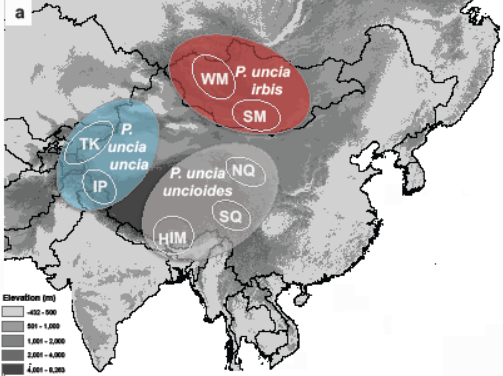Snow leopard, or snow leopard, is a feline from the family of felines living in 12 countries of Asia (Tibet, Mongolia, Russia), mainly in mountains with a height of three thousand meters. In the XX century, the species became endangered, but due to its low availability and extreme secrecy, its phylogeny, important for protection, study and reintroduction, remains unclear. Previously, the snow leopard was moved from the genus Panthera to a separate genus Uncia: despite its relatively large size (103-130 centimeters in length, one third of which falls on the tail), it, like small cats, is not able to growl and at the same time uses Strategy of hunting large cats. Until now, U. uncia was considered to be monotypic.
In past works, the phylogenetic analysis of the snow leopard was carried out, as a rule, using telemetry or museum samples. In the new article, specialists from the University of Ducane, the Mongolian Academy of Sciences and other institutions described the results of the study of the Uncia genome based on animal litter. The biomaterial was collected in 21 settlements of China, Bhutan, Tajikistan and other countries. At the first stage, DNA amplification by quantitative polymerase chain reaction (PCR) allowed the authors to identify individuals on eight microsatellites (short monomeric repeats). Then, to improve the accuracy of the data, they selected 33 microsatellites and tested them on 70 samples.
Additionally, scientists sequenced three fragments of mitochondrial DNA (mtDNA) of animals, but this did not allow to determine the structure of the population. Therefore, they carried out a large-scale simulation of the process of distribution of snow leopard populations with refinement of data by the main component method and various Bayesian methods, and also checked the frequency distribution of alleles with the help of 26 third-party samples from India. According to the results, approximately 7782 years ago, the population of the snow leopard could “pass” the “bottle neck” and stabilize the number to the current level of 1279 years ago. Meanwhile, PCR revealed specific groups of animals corresponding to the habitat.

Areas of habitation of the selected subspecies / © Jan E. Janecka et al., Heredity, 2017
The greatest genetic similarity was demonstrated by snow leopards inhabiting the north and south of Qinghai Province, in India and Pakistan, in Tajikistan and Kirghizia and in the west and south of Mongolia. The minimum similarity was observed between the snow leopards from the south of Mongolia and the south of Qinghai, from the west of Mongolia and the south of Qinghai, from the south of Mongolia and Tibet, Bhutan and Nepal. Thus, scientists divided the sample into three categories. To the “central” area, they attributed snow leopards from the Tibetan plateau and the main part of the Himalayas (Bhutan, Nepal, Tibet, north and south Qinghai). To the “Western” – from the west the Himalayas (India), from Tajikistan and Kyrgyzstan, to the “northern” – from the south and west of Mongolia.
According to the proposed classification, zoologists identified three subspecies of the snow leopard (using the “outdated” typification of the genus Panthera): P. uncia uncioides, P. uncia uncia and P. uncia irbis, respectively. According to them, the work clarifies the evolution of the snow leopard and allows taking measures to protect it taking into account regional and genetic specifics.
Scientists have identified three subspecies of snow leopard











